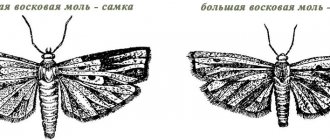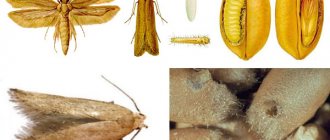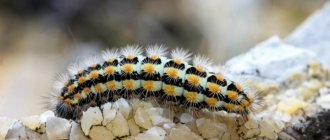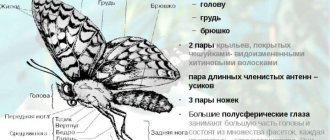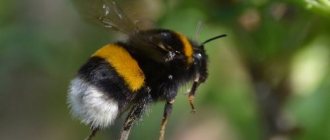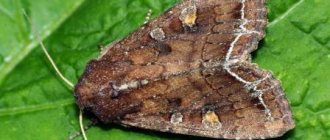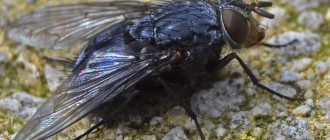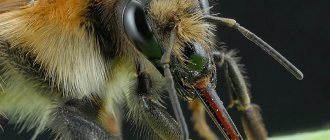The moth is represented not only by an inconspicuous butterfly, which even children know about. In fact, this is a whole group of insects that differ in their characteristic appearance and biological characteristics. Among the representatives, if we consider the question of what a moth looks like, you can find large and small individuals. The insect lives on every continent and has the ability to adapt to any external conditions. Caterpillars eat wool and bark, wax and horns, leaves and even ant eggs. It is problematic to find objects in the organic world that are not associated with the life activity of these small butterflies.
Mole photo
general characteristics
Caterpillar and moth pupa.
The moth looks like a small brownish-yellow, gray or white butterfly with silvery pollen on its wings. It lives mainly in dark places inaccessible to sunlight. For example, in cabinets, pantries.
The larvae that hatch from the eggs prefer to be in the dark, where they are difficult to notice. It is the larvae that cause the most harm. They eat just enough to transform into a butterfly.
Natural "camouflage"
Nature gave such an inconspicuous color to moths for a reason. First of all, because the earthy shade is an excellent protection and allows you to avoid an unpleasant encounter with a hungry predator. An interesting fact is that representatives of different species of moths living in a particular environment acquire colors in accordance with its conditions. For example, the development of moths of forest species is more characterized by a greenish tint, while others are more characterized by the color of the bark of trees, which are more abundant in this area.
But science has become aware of an even more unique phenomenon, a property that only very few representatives of the insect world can boast of. It has been observed that in urban areas where there is heavy soot pollution, some species of moths actually become darker in color than insects of the same species living in less polluted areas.
Another effective form of camouflage is the shape that the insect takes on when at rest. Species that live primarily in tree crowns, as a rule, do not fold their wings at all in order to be more like dry leaves, while “grass” ones actually extend their wings into a line so that they cannot be distinguished from a blade of grass. Not least important is the flight strategy of the moth.
Few of these species fly straight and slowly. Many of us have observed house moths flying around in such a way that it becomes difficult to catch them. Light excites the insect, forcing it to be even more active, so the closer the light source, for example, a light bulb, the faster the moth will fly and the more chaotic at first glance its direction vector will be, which most often becomes circular.
An effective form of defense that other flying insects could take a few lessons from the moth is mimicry. Mimicry is the ability of a living organism to simulate the appearance of a larger or more threatening creature. This form of defense is used both by caterpillars with tails that look like the large head of a poisonous snake, and by adult individuals, whose war-spotted coloring on the outer surface of their unfolded wings scares off even large birds. Mimicry is also characteristic of some species of butterflies.
Features of reproduction
A moth goes through the following stages during its life:
- The butterfly lays eggs, from which larvae appear, which pupate, and from them butterflies emerge. Larvae that appear from eggs laid by a butterfly in the fibers of fabric or fur are dangerous for things. It is important to know that in a city apartment the insect is able to lay eggs all year round.
- The egg develops for two weeks at a temperature of +20 degrees, the development period of the larva is from three to ten months, during which time it forms a cocoon around itself from the material in which the larva started.
- After emerging from the cocoon, the butterfly lives for 2-4 weeks; it flies mainly at night, but poorly, since its wings are poorly developed. Throughout her entire life, she lays eggs.
What harm does
The insect is not dangerous to humans. It does not bite and does not carry infections on its paws that threaten people. Kitchen moths do not eat clothes made from natural fabrics, so you don’t have to worry about the safety of your items.
Only food harms gray butterflies - a large number of food moth larvae feeding on food damages them irrevocably.
The materials become unsuitable for consumption or further processing. All you can do is get rid of spoiled grains or nuts as soon as possible to prevent contamination of other foods.
Varieties of moths
Today, many species of moths are known that live in closets, beds or warehouses. Although they live in different places, they cause equally great harm.
Popular species living in the house
There are several subspecies of what types of moths there are. They have differences in lifespan, size and external features. Most often, typical methods that work the same way help fight them.
Fur moth
A fur moth butterfly with shiny wings, they are dark yellow on top, the bottom layer is light gray. Its wingspan is 14-15 mm.
Fur moth.
The fur coat pest feeds on clothing made from natural materials.
Its larvae look like white caterpillars, almost transparent, so that the contents of the stomach are visible through their skin; there are eight short legs on the abdomen. The larvae feed on fur products, preferring arctic fox and mink.
Clothes moth
Clothes moth.
In this species, the wings at the base have a purple tint, towards the middle they become yellowish and at the end of the wings there are small brown spots. The wingspan of the clothes butterfly is up to 22 mm.
Its larva is covered with white fluff and looks like a larva of the fur coat variety. It is found in the folds or inside of woolen fabric and quietly eats large areas of the product. It is kept on clothes using a fixed cover.
Furniture moth
Furniture moth.
A furniture moth butterfly with shiny silver-yellow wings, the head is dark yellow, the wings at the base have a brown tint. It differs from other species of moths in the absence of mouth tentacles.
First, the furniture larva eats the hair stuffing in the soft parts, then, closer to the pupation period, it begins to gnaw tunnels in the hard parts of the furniture. Pupation occurs under chairs, sofas, armchairs; there are many white cocoons there.
In winter, the larvae develop within 5 months, in summer this happens faster - about 2 months.
Agricultural pests
The pest causes great damage to grain crops such as wheat, barley, oats, and rye. There are two types: grain and rye. Even a small number of moths, if not destroyed promptly, can spoil large stocks.
grain moth
Grain moth.
This species is silvery-white with a bright brown pattern on the wings, and its abdomen is gray. Wingspan up to 15 mm. The grain moth reproduces mainly in spring and summer. It can be found most often in places where grain crops are stored.
The female lays up to a hundred eggs directly on the grain, sticking one or two eggs to each grain. It connects several grains using a sticky liquid that looks like a spider's web. The female is inside this lump and feeds on grains; in order to move, she needs to drag the entire bunch with her.
The grain species pupates in cracks in the floor or walls. It also feeds on dried fruits and plant seeds.
Rye moth
Rye moth.
The rye has dark yellow hind wings with a brown edging. Its wingspan is up to 13 mm. Distributed mainly in central Russia.
Eggs are laid at the end of summer on emerging winter crops and wild cereals. The parasite eats away the core of the stem and overwinters in it; the larvae pupate closer to mid-summer.
Potato moth
Potato moth.
Its very name says that this pest attacks potatoes. She looks unattractive, her wings are dirty gray with dark spots. Its larvae are light green or pink. The hatched one has long whiskers and a body with folded wings up to 7 mm. The potato moth lives only a few days. Her appearance helps her remain almost invisible. The females lay their eggs on the lower part of the leaves, and the hatched larvae grow very quickly.
Potato plantings suffer from parasites. This subspecies can withstand temperatures up to +4 degrees and does not die. Some parasites get into potato tubers and survive the winter in storage areas. In the spring, they again fall into the soil when planting potatoes.
Cabbage moth
Cabbage moth.
This species causes damage to cruciferous plants. The appearance of the cabbage moth differs from other species: the body is light green in color with small fibers, the wings are fringed at the edges. Its larvae have brown heads.
The cabbage specimen flies poorly, does not move far from its cocoon, one or two individuals can be seen on a leaf, and they rarely gather in groups. The eggs are green and almost invisible on the leaves.
food moth
Food moth.
This moth harms cereal stocks whose storage conditions are not met. Food moths also live in the wild, steppes or forest-steppes, eating nuts or fruits.
The color of the moth is discreet, the body length with folded wings is up to 8 mm. The caterpillar is pink or light yellow in color and has a smooth body. Ideal conditions for development are temperature +25 degrees and humidity 50%. All stages of development take more than 1.5 months. This is due to the fact that this subspecies has large food reserves.
Chestnut moth
Chestnut moth.
Harmful to chestnut and maple leaves. The chestnut moth spends the entire winter in the pupal state, and as the weather warms, adults emerge. The offspring of the chestnut tree appear in two weeks and immediately cling to the young foliage.
The defeat leads to shedding of leaves and death of the tree. You can notice the presence of parasites by orange spots on the leaves. Small wood-colored cocoons can be hung on the underside of the foliage.
Gallery
- Plume moth diagram by Robert Hookes Micrographia
- Leaf butterfly (Pergesa acteus
)
- Giant gray moth (Agris convolvuli
)
- Oleander moth or army moth (Daphnis nerii
)
- Six-spotted butterfly mating (Zygaena filipendulae
)
- Protective silk (or similar) case (cocoon)
- Caterpillar dead hawk head
- Marriage couple Laothoe Populi
, or poplar hawk moths, showing two different color variants
- White sphinx moth in Colorado, USA
- Close-up of a common moth
- Giant silk moth (Adelavalkeria tristigma
)
- Adult emperor moth (Gonimbrasia belina
)
Reasons for appearance
Depending on the type of insect, the reasons for the appearance will be different, but all of them can get into the house from neighbors or from the entrance through open windows or doors. Often it gets inside from the ventilation. If several individuals have appeared among neighbors, then there is a high probability that they will end up in apartments below and above. Those located above grocery stores or warehouses are also at risk.
Fur moths can get in when purchasing a product or with a new cabinet. Clothes and furniture can be found in the same way. This happens if rags, carpets or old furniture are brought into the home.
Agricultural pests can come from infested storage or grain. They also overwinter inside vegetables and quickly begin to develop in the spring.
Food moths can get in with cereals, especially those sold by weight. Eggs and larvae are very tenacious and, when exposed to favorable conditions, begin to reproduce.
Notable butterflies
- Atlas moth ( Atlas atlas
), the largest moth in the world - White witch moth ( Thysania agrippina
), the lepidopteran with the longest wingspan - The Madagascar moth ( Chrysiridia rhipheus
), is considered one of the most impressive and beautiful Lepidoptera.[28] - The death hawk hawk ( Acherontia
spp.), is associated with the supernatural and evil and has been featured in art and film. - Pepper moth ( Biston betularia
), the subject of a famous study of natural selection - Luna moth ( Actias luna
) - Fat moths ( Aglossa cuprina
), which were known to feed on the rendered fat of humans[29] - Emperor moth ( Opodifthera eucalyptus
) - Polyphemic moth ( Anteraeus polyphemus
) - Bogong moth ( Agrotis infus
), which is known to have been a food source for south-eastern Indigenous Australians - The ornate moth ( Utetheisa ornatrix
), the subject of numerous behavioral studies concerning sexual selection.
Moths of economic importance
- The gypsy moth ( Lymantria dispar
), an invasive pest of North American hardwoods. - Winter moth ( Operophtera brumata
), an invasive pest of hardwood trees, cranberries, and blueberries in northeastern North America. - Cornworm or cotton bollworm ( Helicoverpa zea
), a major agricultural pest - Indian moth ( Plodia interpunkella
), a major pest of grain and flour - Codling moth ( Cydia pomonella
), a pest mainly of apple, pear and walnut trees. - Light brown apple moth ( Epiphya postvittan
), a highly polyphagous pest - Silkworm ( Bombyx mori
), for its silk - Wax moth ( Galleria mellonella
,
Achroa grisella
), pest of bee hives - Duponchelia fovealis
, an emerging invasive pest of vegetables and ornamentals in the United States.
Methods of disposal
If there are moths in your apartment, there are several ways to get rid of them:
- Special aerosol. This remedy will help if you find the place where it lives and treat it. After using the aerosol, you need to leave the house for several hours, and after returning, do a wet cleaning.
- Velcro or moth traps. They are hung in the kitchen or near cabinets, the moth sticks and dies. Often they are simple paper, with a sticky backing, and are attached to inconspicuous areas of the cabinet.
- Pills . They can be placed in areas where moths are likely to appear.
- Folk remedies . This includes various repellent compositions of herbs, washing with soap or vinegar.
- To combat agricultural moths, indoor treatments are carried out; infected grain is heated or frozen. The room must be disinfected and dried well.
What are the best anti-moth products?
ChemicalFolk
Vegetables in which moths have infested are also treated. You can use chemicals or traditional methods that last longer and are more effective.
Any moth does not like strong movements and temperature fluctuations. Therefore, temperature treatment helps at home. Moreover, it tolerates both frost and heat equally poorly.
Fighting methods
It’s not enough to know where moths come from in the house. You need to know how to deal with the harmful moth that destroys groceries and things. There are several control methods, the most effective of which is chemical. It involves the use of insecticides. True, this method is applicable only if we are not talking about food moths. It is forbidden to treat groceries with toxic preparations.
As for the choice of insecticide, a wide range of drugs is available on store shelves today. The first thing you need to pay attention to is the toxicity class. In residential premises, it is advisable to use low-toxic drugs, which, as a rule, are not cheap. But, as for pricing policy, any good pesticide will not be cheap. Cheap insecticides, as practice shows, are ineffective. It is also worth paying attention to the presence of odor. Preference should be given to odorless insecticides, which are difficult to remove from the house after treatment.
The next group of methods are biological. These methods involve exposing the moth to high or low temperatures. The butterfly dies at temperatures exceeding 600 C or below -200 C. Therefore, things can be washed at the desired temperature, or better yet, boiled, or taken out into the cold. As for groceries, they can be processed at high temperature in the oven.
Prevention measures
There are a number of necessary requirements that will help keep your belongings and products safe and sound.
- When purchasing groceries, pay attention to the condition of cereals, flour, dried fruits, and herbs.
- Keep food in the house in closed jars or bags soaked in salt water.
- It is recommended to ventilate kitchen cabinets frequently, wipe the shelves with vinegar, and place lavender or orange peels on them.
- Observe the shelf life of products, especially nuts and dried fruits, as moths often infest them.
- Woolen and fur items should be kept clean, and any deterrents should be placed in the closet.
- When purchasing, carefully inspect for damage or moth larvae. It is important to regularly ventilate and inspect things.
- When preventing agricultural moths, premises are ventilated and treated before storing a new crop.
What does it eat and what is it afraid of?
The kitchen moth is almost omnivorous. He eats not only food, but also fresh fruits and even dried herbs or spices. Adult flying individuals do not feed at all: they do not have oral organs or a digestive system. The danger comes from food moth larvae, which require a lot of food to pupate. The following products are unsafe:
- Cereals - semolina, rice, millet, buckwheat.
- Pasta.
- Cereals - oatmeal, seeds, bran.
- Dried fruits - prunes, dried apricots, raisins, figs.
- Flour and baked goods: baked goods, cookies, crackers.
- Cocoa and delicate spices.
- Nuts - hazelnuts, almonds, cashews.
- Sugar.
Food moths do not tolerate the smell of citrus fruits, lavender, tansy, wormwood, rosemary, dill and cloves. Therefore, for preventive purposes, you can hang bunches of dried herbs in the kitchen or use essential oils: scent the air, clean cabinets, add to water when wet cleaning.
Phases of transformation of eggs into food moths
How to fight the parasite
There are many different means to combat garden pests. This includes toxic substances, insecticides or more gentle folk recipes (herbal infusions, decoctions). Which method to prefer is up to each gardener to decide for himself. But remember that in garden plots where there are a lot of fruit and fruit crops, the use of toxic chemicals is not always acceptable.
Expert opinion
Mityuk Stefania Bogdanovna
It is best to start exterminating moths in the spring, when plant buds are just beginning to bloom.
Biological drugs
These are less toxic and safer products that do not cause damage to living organisms and crops. They begin to work with biological preparations when the air temperature warms up from +15⁰С. With such means you can spray cultivated plantings without restrictions. Treatment must be repeated every 10-12 days until the pest is completely destroyed.
The most effective biological agents include the following (the norm is given for mixing the powder in 10 liters of warm water):
Lepidocid: 25-30 g;
Bitoxibacillin: 50-80 g;
These drugs are especially effective in killing potato, onion and cabbage moths. At the same time, they rid the garden of the larvae of the Colorado potato beetle, cabbage whites, silkworms and leaf rollers. But keep in mind that these products are only effective for adults. Larvae and caterpillars will have to be collected by hand.
All plantings are treated with biological agents, not just affected plants.
Insecticides
If the garden is severely damaged, it is no longer possible to do without chemicals. Do not forget that insecticides are toxic, and carry out work with personal safety equipment. Treatment with chemicals begins in May, and is repeated in July, during budding. The crops are processed for the third time after harvesting and removal of plant residues.
Among the effective means it is worth highlighting the following:
| Name | Description | Consumption rates |
| Destroys almost all garden pests, including tomato and cabbage moths. | 10 ml of the drug per bucket of water, consumption: for adult plants 5 liters, for young seedlings 2 liters. | |
| Effective for ermine moths. | Dilute 60 g of the drug in 10 liters of water. | |
| Used against all garden pests. | 40-50 ml per 10 liters of water, the period of protective action is 12 days, it increases when the temperature rises from +26⁰С. | |
| Works well against cabbage and onion moths, destroys insect eggs and larvae. | Spraying according to consumption rates: 100-1000 l/ha (depending on the type of plants being treated). | |
| Broad spectrum of action, effective for all types of moths. | 8-12 ml per 10 liters of water (depending on the type of crop being treated), consumption: 250-300 l/ha. | |
| Effective for ermine, cabbage and onion moths. | 15 ml per 1/2 bucket of water. | |
| Universal, copes well with all types of moths. | 1-5 tablets per 10 liters of water (depending on the type of crops being processed). |
It is better to apply insecticides in the morning (after the dew has left) or evening (after sunset), when it is dry and windless. It is desirable that the air temperature is up to +25⁰С. The poison these products contain effectively destroys both adult insects and their caterpillars, larvae and eggs.
It is prohibited to treat plants with insecticides when they are flowering. The poison can accumulate in flowers and cause irreparable damage to bees.
Insecticidal lamps
These devices are harmless to living organisms and are good helpers in killing garden moths.
The devices work when connected to a regular outlet. Ultraviolet light attracts an insect, which immediately dies when it hits the installed metal mesh (they are energized).
Among the most popular models are the following:
- Energy;
- KillPest;
- Biogrod;
- MoEl;
- Samarai.
Insecticidal lamps are easy to use, do not emit harmful fumes and have a long service life.
Expert opinion
Mityuk Stefania Bogdanovna
For garden plots, it is better to take high-power models. The weaker ones are suitable for work inside the house.
Folk remedies
Such methods are often used for prevention purposes. But when a small number of moths appear, they also become effective.
| Decoction | How to cook | What moth does it work against? | Features of use |
| From wormwood | A mixture of wormwood and marigolds (200 g) is poured with water (5 l), brought to a boil, boiled for about 1-1.2 hours, the decoction is diluted with water (3 l). | Ermine, poplar. | Spray the plantings three times in the spring, when the buds swell. |
| From wood ash | Stir 10-15 g of ash in 10 liters of water, add 25 ml of liquid soap, stir. | Onion, cabbage. | Spraying is carried out three times per season. |
| From tomato tops | Pour the raw material (2 kg) with water (5 l) and boil for 30-35 minutes, strain and dilute with cold water until the volume increases 3 times. | Cabbage, tomato. | Spray every 2-3 days until the moths are completely eliminated. |
| From pepper | Pour 100 g of raw material into 1 liter of water, bring to a boil and cook for 35-40 minutes, then leave for a day; for spraying, the solution is diluted with water 5 times (you can add a little liquid soap). | Cabbage, kidney, onion. | Treatment is carried out twice with an interval of 4-5 days. |
| From tobacco | Steam shag (100 g) with boiling water (10 l), leave to infuse for 7-8 days, strain. | Rowan, bud. | Treat three times with a break of 3-4 days. |
| From dandelion | Mix 500 g of crushed dried flowers and 25 ml of liquid soap in 10 liters of water and leave for 3 hours. | Grape, apple. | Three-time treatment. |
| From garlic | Calendula seeds (4 cups) and chopped garlic (100 g) are poured with boiling water (10 l), left for 2.5-3 hours. | Onion, potato. | Spray the plants 2-3 times per season. |
To save your hives from wax moth attacks, it is recommended to do the following:
- Diversify the plantings in the apiary with lemon balm, marigolds, mint, pelargonium and wormwood. The pungent smell of plants will repel moths from the hives.
- Place several containers filled with honey and beebread with the addition of yeast next to the hives. These traps are installed after the bees have flown out and are removed early in the morning.
- Dig small ditches around the hives and fill them with water.
- Make a solution of mint (2 parts dry plant) and 1 part water. The prepared liquid is poured into the hives between the frames overnight. In the morning, all that remains is to remove the frames and destroy the collected moth larvae.
7) Delicacy moths
In some parts of the world, moths are an important food item for humans. More than 90 percent of people in some African countries eat moths and caterpillars, according to a 2004 study by the Food and Agriculture Organization of the United Nations. Caterpillars are rich in protein and healthy fats. Research shows that 100 grams of these insects provides your daily requirement of vital minerals such as potassium, calcium, zinc and iron.
6) Moths are food for many animals
Due to their wide distribution, moths are important links in food chains, being at the lowest level. They are eaten by many animals, including bats. Some moths were forced to evolve means of defense against these predators. For example, shemale
produce ultrasonic clicking signals that effectively confuse mice, allowing the moth to fly away and escape pursuit.
The caterpillars of many moths are also food for living things. 95 percent of nesting birds feed their chicks insects, with caterpillars making up the majority of them.
